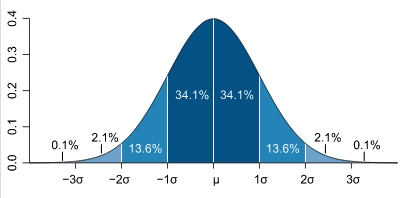Sigma
|
Most have heard of the "bell curve" in mathematics. This is the shape that describes the probability that a given percentage of measurements will fall within a certain region under a standard bell curve. This shape is found in nature - so its one that mathematicians use often. This shape of the standard bell curve is called "Normal Distribution" or "Gausian Distribution." SIGMA A statistical measurement called "standard deviation" is also referred to as "sigma" on the horizontal axis of a bell curve. Basically, this is a measurement of how much the measurements vary around the actual value between the sigma line on the right and the sigma line on the left.
|
If someone says that the the probability that a measurement will fall within 1 sigma, then that person is referring to the width that is formed by the standard deviation.
Now three sigma is 3* the standard deviation, which statistically mean that 99.73% of the time a measurement is made it will be within 3*the standard deviation of the actual value. It is thus a way to compare how good the measurement method is.
In similar ways 2 sigma means within 95% of the actual value and 6 sigma means as close to always as is resonable to ever need.
